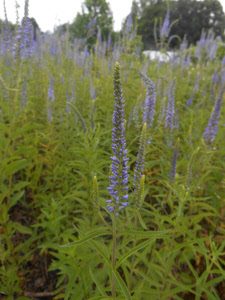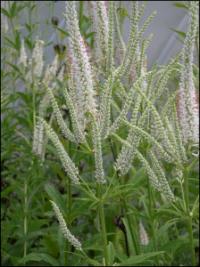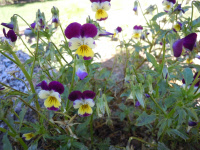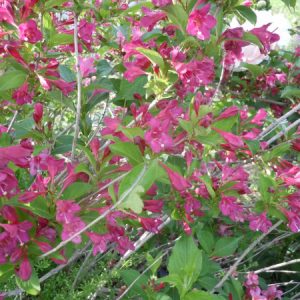Shop
Showing 777–784 of 788 results
-
Veronica spicata Speedwell Z 4-8
Erect crowd of bluish-purple star-shaped flowers cover terminal spikes all summer growing high above basil foliage. If deadheaded blooms all summer.
Erect crowd of bluish-purple star-shaped flowers cover terminal spikes all summer growing high above basil foliage. If deadheaded blooms all summer.
Size: 24" x 18-24"
Care: Sun in well-drained soil
Native: Hilly pastures in Europe and North Asia
Wildlife Value: attracts butterfliesAccording to Christian tradition, as Jesus carried the cross to Calvary a woman wiped his face with her handkerchief, leaving the imprint of Christ’s features, the vera iconica, meaning “the true likeness.” When the Catholic Church canonized the woman, the Church gave her the name Saint Veronica. Medieval gardeners named this plant after her due to a perceived likeness of the flower to her handkerchief. Veronicas have been in cultivation since at least Medieval times. Europeans made tea from V. spicata. This was planted in a symmetrical garden at Versailles.
-
Veronicastrum virginianum, Culver’s root Z 4-9
Tall, graceful ivory spires made of multitudes of small tubes crowd along the stem, arranged like a candelabra. This flowers from early to mid-summer.
Tall, graceful ivory spires made of multitudes of small tubes crowd along the stem, arranged like a candelabra. This flowers from early to mid-summer.
Size: 4' x 18"
Care: full sun to part shade in moist soil
Native: From Canada to Texas, Wisconsin native
Wildlife Value: Numerous bee species, including the Rusty patched Bumble Bee, wasps, and butterflies collect pollen and drink the nectar.Used by American Indians as a laxative and to induce vomiting and clean blood. Cherokee cured typhus and inactive livers with Culver’s root. Seneca Indians used the root in their ceremonies. Sioux also used this to stimulate the liver. They also burned the root for the smoke to purify those who had contact with a dead family member. 1st collected by Rev. John Banister (1649-1692) who moved to colonial Virginia in 1678. A gunman mistakenly shot and killed him while he collected plants. Colonial Puritan Cotton Mather unsuccessfully attempted to use this plant to cure his daughter’s tuberculosis in 1716. Colonial nurseryman John Bartram (1699-177) recorded medicinal uses saying, “One Handful of the Roots of this Plant, boiled in a Pint of Milk, and drank, is used by the back Inhabitants for a powerful Vomit.” Pressed specimen in Emily Dickinson’s herbarium.
-
Viola corsica Corsican violet Z 4-8
Rare species violet. Clouds of blue violets with veined heart leading to tiny yellow centers
ARCHIVED
Note: This is a plant not currently for sale. This is an archive page preserved for informational use.
Rare species violet. Clouds of blue violets with veined heart leading to tiny yellow centers from late spring thru fall-blooms its head off. Reliably perennial. More heat tolerant than pansies.
Size: 5-7” x 8-10”
Care: sun to part shade in moist well-drained soil.
Native: Corsica1st described by Swedish botanist Carl Fredrik Nyman before 1893.
-
Viola tricolor Johnny jump up, Heartease Z 2-9 RESEEDING short-lived perennial
Cheerful purple, yellow, and white blooms from spring to late fall in cool weather.
Cheerful purple, yellow, and white blooms from spring to late fall in cool weather.
Size: 3-5” x 4-6”
Care: Sun to part shade in moist well-drained soil
Native: Europe and Asia
Wildlife Value: Violas are the sole food source for the caterpillar of Fritillary butterflies.Viola was named after a mythical young woman who Zeus loved and who Zeus’ wife harassed. Athens adopted the V. tricolor as its symbol. Pliny (24-79) prescribed it for headaches in ancient Rome. Mentioned repeatedly by Shakespeare. In the 1500’s the plant was used to make a medicinal tea to cure chest and lung inflammations, and later to cure impetigo and ulcers. Grown in the Eichstätt Garden, the garden of Johann Konrad von Gemmingen, prince bishop of Eichstätt in Bavaria, c. 1600.
This is the origin of all pansies which resulted from 30 years experiment by English gardener to Lord James Gambier (governor of Newfoundland), William Thompson in early 1800’s. The 1st pansies came from a cross of V. tricolor with V. lutea and V. altaica. When Napoleon Bonaparte died Viola tricolor found in his locket with a snip of Josephine’s hair. Thomas Jefferson imported Viola tricolor from France in 1767. Grown at Elgin Botanic Garden, America’s 1st botanic garden, 1811. Pressed specimen in Emily Dickinson’s herbarium.
-
Weigela florida Shrub Z 4-9
Rosy pink, white or red trumpets in May and June,repeating sporadically all summer, described by Robert Fortune as ”fine rose-coloured flowers, which hung in graceful bunches from the axils of the leaves and the ends of the branches”
Rosy pink, white or red trumpets in May and June,repeating sporadically all summer, described by Robert Fortune as ”fine rose-coloured flowers, which hung in graceful bunches from the axils of the leaves and the ends of the branches”
Size: 5’ x 4’
Care: full sun to part shade in well-drained soil. Blooms on both old and new wood so can prune anytime. Pruning promotes compact, bushy habit & more flowers.
Native: ChinaNamed for German professor Christian Ehrenfried Weigel. Introduced to western cultivation in 1845 by Robert Fortune who found it growing in a northern Chinese garden. A favorite of Queen Victoria.
**LISTED AS OUT OF STOCK BECAUSE WE DO NOT SHIP THIS ITEM. IT IS AVAILABLE FOR PURCHASE AT OUR RETAIL LOCATION.
-
Wisteria frutescens syn. Wisteria macrostachya America wisteria Z. 5-8
Lush, dense, drooping, fragrant purplish-blue, pea-like racemes in late summer on new fragrant purplish-blue, pea-like. drooping flower-clusters in early summer on new stems.
Lush, dense, drooping, fragrant purplish-blue, pea-like racemes in late summer on new fragrant purplish-blue, pea-like. drooping flower-clusters in early summer on new stems.
Size: 12-20’ x 4’
Care: sun to part shade in moist, mildly acidic soil For best flowering trim vine to four buds from last year's new growth in late winter or early spring, before this year's growth begins. A legume, so it enriches the soil by adding nitrogen. Seed pods poisonous.
Native: Virginia to FL, west to TX, north to IL
Wildlife Value: Larval host for Marine Blue skipper butterfly. Deer resistantCollected before 1753. Wisteria named “in memory of Caspar Wistar,(1761-1818) M.D. late professor of anatomy in the University of Pennsylvania, and for many years president of the American Philosophical Society: a philanthropist of simple manners, and modest pretensions, but an active promoter of science.” Thomas Nuttall.
-
Xanthorhiza simplicissima Yellowroot Z 4-9
Short, spreading shrub, blooms sprays of plum-colored flowers in spring, then forming berries. For dessert its leaves turn yellow, purple and maroon in fall. Excellent groundcover under trees and for erosion control. Will suppress weeds.
OUT OF STOCK
Short, spreading shrub, blooms sprays of plum-colored flowers in spring, then forming berries. For dessert its leaves turn yellow, purple and maroon in fall. Excellent groundcover under trees and for erosion control. Will suppress weeds.
Size: 2-3” x spreading
Care: filtered sun to shade in moist to moist well-drained, slightly acidic soil
Native: Maine to FL and west to Ohio
Wildlife Value: food and habitat for several birds.Colonial horticulturist William Bartram found it near Buffalo Lick GA in 1773. He wrote: “This evening I discovered a very curious Little Shrub, growing on the bottoms of these Hills & on the steep banks of the Creek. . . the root affording strong Yellow Tincture. . . It has long slender branching Roots which run & spread about . . . filling large patches of ground . . . it is in my opinion a very valuable Shrub . .”
Native Americans dyed fibers with the yellow root.
-
Xerophyllum tenax Turkey beard, Indian basket grass Z 5-8
Plume of fragrant white flowers May-August on naked stalks rising from mound of grassy foliage, actually a lily.
OUT OF STOCK
Plume of fragrant white flowers May-August on naked stalks rising from mound of grassy foliage, actually a lily.
Size: 3-5’ x 24-30”
Care: sun to part shade in well-drained soil
Native: British Columbia, to Montana & WYSeveral western Indian tribes wove baskets & hats from the leaves & roasted the roots for food. Blackfoot applied the plant to wounds to stop bleeding and repair breaks & sprains. Collected by Meriwether Lewis June 15, 1806 just east of Weippe Prairie and west of Bitterroot Mountains in Idaho.






